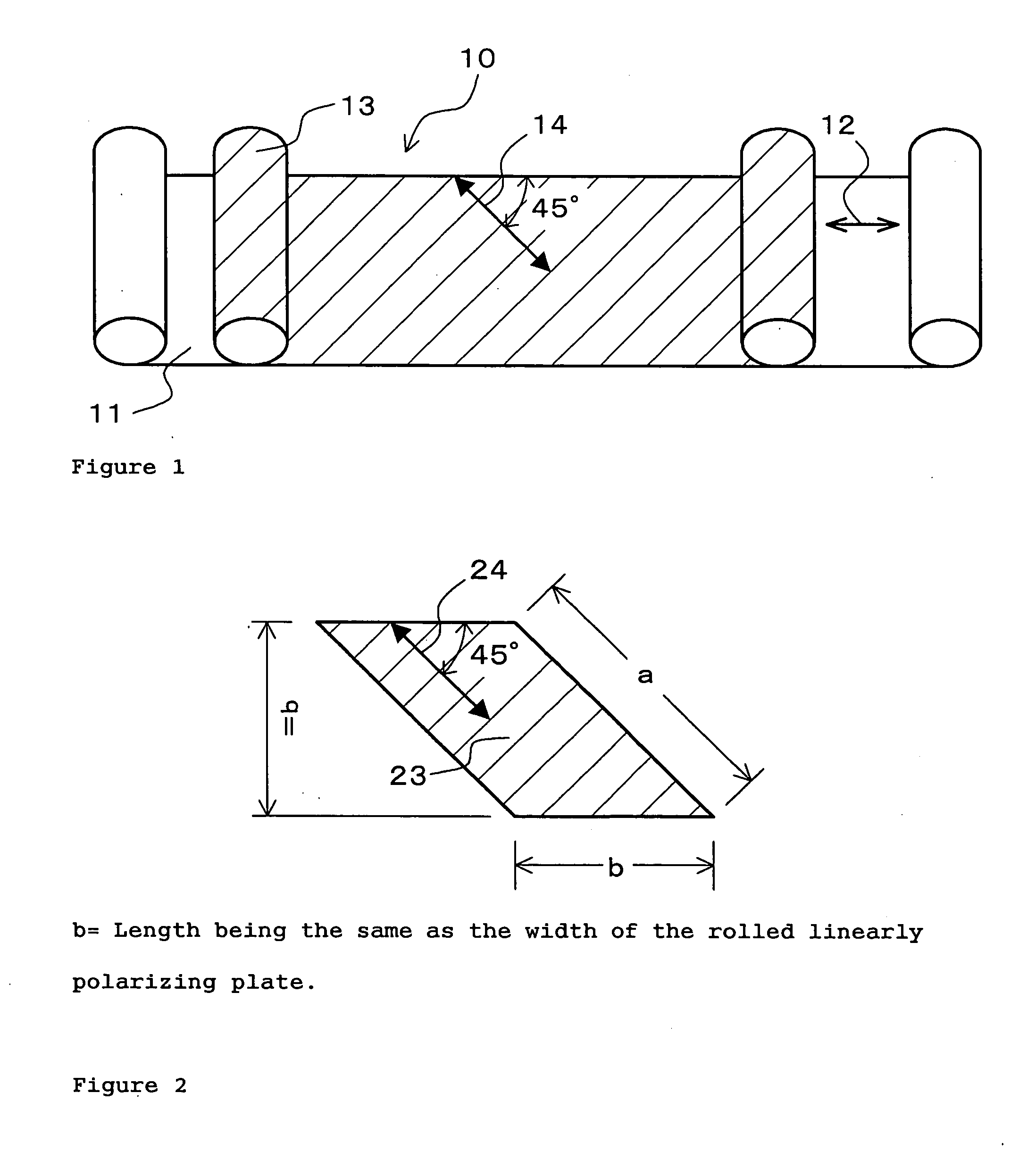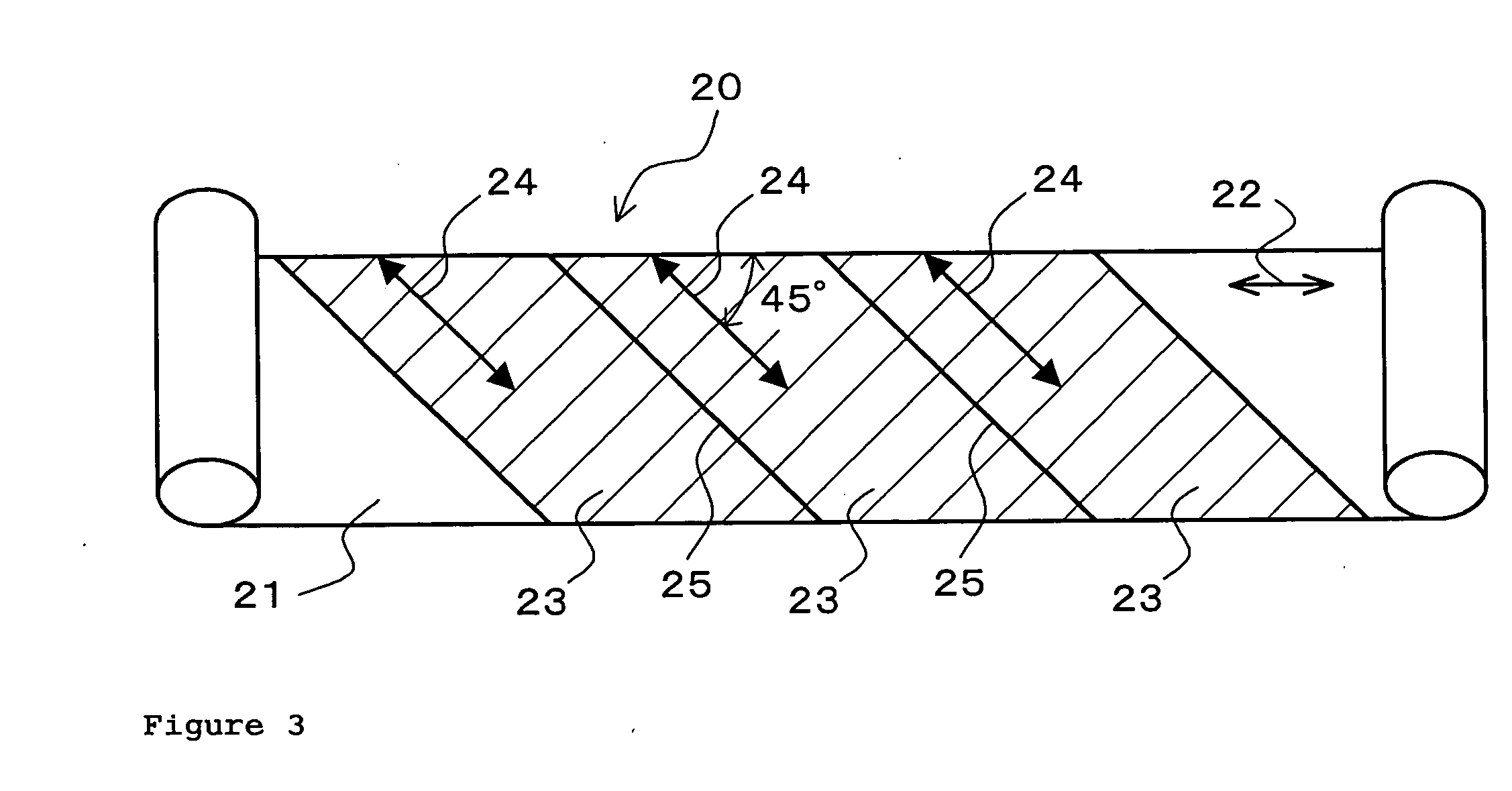Elliptically polarizing plate and method of producing the same
a technology of elliptical polarizing plate and elliptical polarizing plate, which is applied in the direction of polarizing elements, thin material handling, instruments, etc., can solve the problems of low yield, large loss of materials during the operating process, and increased cost, so as to reduce thickness and improve production efficiency. , the effect of good yield
- Summary
- Abstract
- Description
- Claims
- Application Information
AI Technical Summary
Benefits of technology
Problems solved by technology
Method used
Image
Examples
example 1
[0074] (a) Rolled Quater-Wave Plate
[0075] A rolled Quater-Wave plate was prepared that has a slow axis in the direction inclined at an angle of 45° within a film face relative to the longitudinal direction of a rolled transparent substrate, with polymerizing liquid crystal compounds being orientated along a single face of the rolled substrate produced by saponifying a triacetyl cellulose film having a thickness of 80 μm (“Fujitac TF80UL” available from Fuji Photo Film Co., Ltd.) by making use of a photo alignment layer.
[0076] (b) Rolled Linear Polarizing Film
[0077] A rolled polyvinyl alcohol film having a thickness of 75 μm, an average polymerization degree of about 2,400, and a saponification degree of 99.9 mol % or more was uniaxially stretched with dry process at a stretching magnification of 5-fold, and then immersed in an aqueous solution of iodine / potassium iodide / water in a weight ratio of 0.05 / 5 / 100 at 28° C. for 60 seconds while keeping the strain. Then, the resulting fi...
example 2
[0082] When sheet-like elliptically polarizing plates (length 100 mm×width 50 mm) were cut from the rolled elliptically polarizing plate (width 100 mm×length 5 m, the longitudinal direction and the absorption axis of the linear polarizing plate are laid in parallel) obtained in Example 1 in such a way that the length direction was laid in the absorption axis of the linear polarizing plate, 100 sheets of elliptically polarizing plates without joints were capable of being cut out. In this example, the taking out efficiency R calculated by Equation (1) above was 100%.
example 3
[0083] When sheet-like elliptically polarizing plates (length 50 mm×width 50 mm) were cut from the rolled elliptically polarizing plate (width 100 mm×length 5 m, the longitudinal direction and the absorption axis of the linear polarizing plate are laid in parallel) obtained in Example 1 in such a way that the length direction was laid in the absorption axis of the linear polarizing plate, 200 sheets of elliptically polarizing plates without joints were capable of being cut out. In this example as well, the taking out efficiency R calculated by Equation (1) above was 100%.
PUM
| Property | Measurement | Unit |
|---|---|---|
| wavelength region | aaaaa | aaaaa |
| wavelength region | aaaaa | aaaaa |
| thickness | aaaaa | aaaaa |
Abstract
Description
Claims
Application Information
 Login to View More
Login to View More - R&D
- Intellectual Property
- Life Sciences
- Materials
- Tech Scout
- Unparalleled Data Quality
- Higher Quality Content
- 60% Fewer Hallucinations
Browse by: Latest US Patents, China's latest patents, Technical Efficacy Thesaurus, Application Domain, Technology Topic, Popular Technical Reports.
© 2025 PatSnap. All rights reserved.Legal|Privacy policy|Modern Slavery Act Transparency Statement|Sitemap|About US| Contact US: help@patsnap.com



